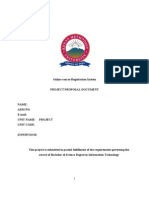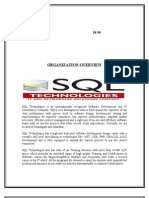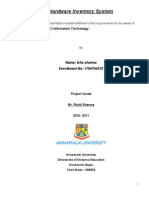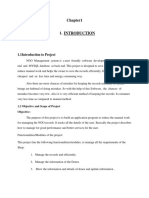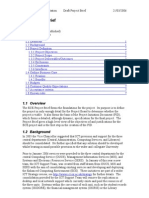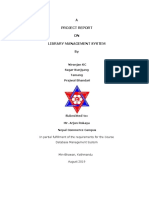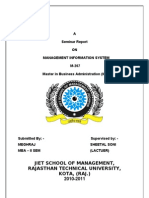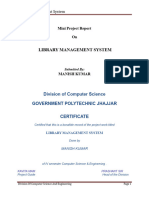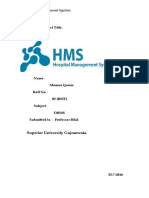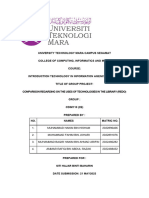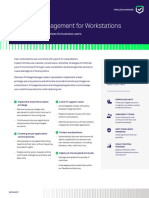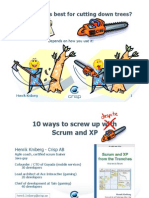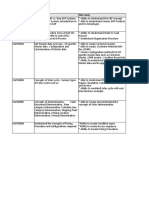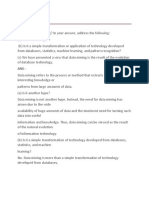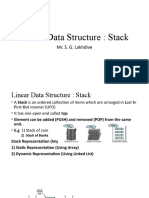Project Report
LIBRARY MANAGEMENT
in partial fulfillment for the award of degree in B.Tech. (Computer Science & Engineering)
Submitted By: Name: Ankush Preet University Roll No: 90470305999 Under the guidance of Name: Mr.Brijesh Kumar Designation: Examination Authority SQL,Chandigarh Submitted To: Mr. Ranjit Singh
Department of Computer Science & Engineering LALA LAJPAT RAI INSTITUTE OF ENGINEERING &TECHNOLOGY, MOGA (2009-2013)
�ACKNOWLEDGEMENT
Outstanding achievements are not possible in vacuum. It needs a lot of help and assistance beside a healthy environment, luckily we have. We are grateful to Mr.Bhupendra Singh , Centre Head, SQL, Centre of Excellence for giving us the opportunity to carry out our training in their esteemed organization. We deem it a pleasant duty to place on record our sincere and heartfelt gratitude to our training guide Mr.Brijesh Kumar (Designated as Senior Trainer in SQL) for her long sightedness, wisdom and co-operation which helped us in tackling crucial aspects to the training in very logical and practical way. We then want to extend our word of thanks and admiration to all the employees of SQL, Centre Of Excellence who made us feel so comfortable in the whole tenure of the training. ANKUSH (90470305999)
�PREFACE
Library Management System is software developed for keeping the records of books in colleges and institutes. It facilitates to access the information of books, issued by the particular student. The information is sorted by the operator and faculty members. The purpose of the library Management System is to computerized the tradition way of keeping records on papers. It is about to manage and keep the record of the individual for current session on Computer rather than doing any paper work. This software is a desktop application. This application will manage and maintain the whole record of library .
�Table of Contents
ACKNOWLEDGEMENT..................................................................................................2 PREFACE...........................................................................................................................3 Table of Contents................................................................................................................4 ABOUT THE ORGANISATION......................................................................................5 SQL-TECHNOLOGIES.....................................................................................................5 Centre of Excellence...........................................................................................................5 SQL Centre of Excellence..................................................................................................6 Microsoft Visual Studio.....................................................................................................8 .NET Framework Conceptual Overview............................................................................9 C#.NET.............................................................................................................................13 ADO.NET.........................................................................................................................15 Microsoft SQL Server......................................................................................................18 SDLC (System Development Life Cycle)........................................................................20 PROJECT..........................................................................................................................27 LIBRARY MANAGEMENT SYSTEM......................................................................27 SNAPSHOTS OF THE....................................................................................................29 PROJECT ALONGWITH................................................................................................29 EXPLANATIONS............................................................................................................29 BIBLIOGRAPHY............................................................................................................36
�ABOUT THE ORGANISATION
SQL-TECHNOLOGIES Centre of Excellence
INTRODUCTION:
The SQL-TECHNOLOGIES has been set up under the aegis of the Department of Information Technology, Chandigarh Administration for implementing the various plans of the Administration to promote the IT industry in Chandigarh. The Chairperson of the Society is the Adviser to the Administrator
OBJECTIVES: 1. To promote application of Information Technology in the Union Territory of Chandigarh in accordance with the IT Policy of Chandigarh Administration. 2. To carry out all such activities that are commensurate with the IT vision of the Chandigarh Administration as outlined in IT Policy. 3. To promote e-Governance, Software Exports, create IT Infrastructure, generate jobs in IT as outlined in the IT Mission of the Chandigarh Administration. 4. To facilitate the establishment and functioning of data processing computer centres. 5. To provide consultancy services and impart training in various disciplines of Information Technology.
�SQL Centre of Excellence
SQL and Microsoft have jointly set up a Centre of Excellence at Punjab Engineering College, Chandigarh. Under the aegis of Department of IT, SQL and Microsoft have jointly set up a Centre of Excellence at Punjab Engineering College, Chandigarh. The Centre is a state-of-the-art Complex spread over an area of 3500 sq. ft. It consists of a spacious Conference Hall, Hi-tech class rooms, 30 work stations, a Meeting Room, and all the latest technological equipment for Training, Software Development and Presentations. Under this understanding the partnership will work towards computerizing organizations in Chandigarh U.T., building skilled technical resources, develop expertise in providing technical consultancy, developing custom applications. Microsoft, in return will provide access to training and skills transfer on Microsoft Corporation technology. The centre is offering various courses like MCSE, MCSD, MCDBA, VB and SQL 2000. Microsoft is carrying out training for the faculty, the students and employees of Chandigarh Administration on its new technologies / products for bench marking and demonstrating an array of Microsoft products, solutions and interoperability with other platforms at this Centre. The Centre of Excellencies being used as a centre for the development of skills for the emerging software industry in the UT. The Centre also provides organized short-term courses for corporate executives, including executives from private companies. High-end training is carried out for the executives as per their requirement. Software engineers deployed by the Department of Information Technology and Microsoft are working on various e-governance projects, some government projects like an accounting package for the Chandigarh Pollution Control Committee, projects related to counselling/guidance (Regional Employment Officer), a project on Loan System for the Social Welfare Department, Developing a library software for the Chandigarh College of Architecture, a project for the ITI Chandigarh and also developing website
�of Chandigarh Administration which includes all public interacting departments of Chandigarh Administration
�Microsoft Visual Studio
Microsoft Visual Studio is an Integrated Development Environment (IDE) from Microsoft. It can be used to develop console and graphical user interface applications along with Windows Forms applications, web sites, web applications, and web services in both native code together with managed code for all platforms supported by Microsoft Windows, Windows Mobile, Windows CE, .NET Framework, .NET Compact Framework and Microsoft Silver light. Visual Studio includes a code editor supporting IntelliSense as well as code refactoring. The integrated debugger works both as a source-level debugger and a machine-level debugger. Other built-in tools include a forms designer for building GUI applications, web designer, class designer, and database schema designer. It allows plug-ins to be added that enhance the functionality at almost every level - including adding support for source control systems (like Subversion and Visual SourceSafe) to adding new toolsets like editors and visual designers for domain-specific languages or toolsets for other aspects of the software development lifecycle (like the Team Foundation Server client: Team Explorer). Visual Studio supports languages by means of language services, which allow any programming language to be supported (to varying degrees) by the code editor and debugger, provided a language-specific service has been authored. Built-in languages include C/C++ (via Visual C++), VB.NET (via Visual Basic .NET), and C# (via Visual C#). Support for other languages such as F#, M, Python, and Ruby among others has been made available via language services which are to be installed separately. It also supports XML/XSLT, HTML/XHTML, JavaScript and CSS. Language-specific versions of Visual Studio also exist which provide more limited language services to the user. These individual packages are called Microsoft Visual Basic, Visual J#, Visual C#, and Visual C++.
�.NET Framework Conceptual Overview
The .NET Framework is an integral Windows component that supports building and running the next generation of applications and XML Web services. The .NET Framework is designed to fulfil the following objectives:
To provide a consistent object-oriented programming environment whether object code is stored and executed locally, executed locally but Internetdistributed, or executed remotely.
To provide a code-execution environment that minimizes software deployment and versioning conflicts.
To provide a code-execution environment that promotes safe execution of code, including code created by an unknown or semi-trusted third party.
To provide a code-execution environment that eliminates the performance problems of scripted or interpreted environments.
The .NET Framework has two main components: the common language runtime and the .NET Framework class library. The common language runtime is the foundation of the .NET Framework. The runtime as an agent that manages code at execution time, providing core services such as memory management, thread management and remoting, while also enforcing strict type safety and other forms of code accuracy that promote security and robustness. In fact, the concept of code management is a fundamental principle of the runtime. Code that targets the runtime is known as managed code, while code that does not target the runtime is known as unmanaged code. The class library, the other main component of the .NET Framework, is a comprehensive, object-oriented collection of reusable types that you can use to develop 9
�applications ranging from traditional command-line or graphical user interface (GUI) applications to applications based on the latest innovations provided by ASP.NET, such as Web Forms and XML Web services. The .NET Framework can be hosted by unmanaged components that load the common language runtime into their processes and initiate the execution of managed code, thereby creating a software environment that can exploit both managed and unmanaged features. The .NET Framework not only provides several runtime hosts, but also supports the development of third-party runtime hosts. The following illustration shows the relationship of the common language runtime and the class library to your applications and to the overall system. The illustration also shows how managed code operates within a larger architecture.
.NET Framework in context
10
�.NET Framework
The Microsoft .NET Framework is a software framework that can be installed on computers running Microsoft Windows operating systems. It includes a large library of coded solutions to common programming problems and a virtual machine that manages the execution of programs written specifically for the framework. The .NET Framework is a key Microsoft offering and is intended to be used by most new applications created for the Windows platform. The framework's Base Class Library provides a large range of features including user interface, data and data access, database connectivity, cryptography, web application development, numeric algorithms, and network communications. The class library is used by programmers, who combine it with their own code to produce applications.
Principal design features:
1. Interoperability: Because interaction between new and older applications is commonly required, the .NET Framework provides means to access functionality that is implemented in programs that execute outside the .NET environment. Access to COM components is provided in the System.Runtime.InteropServices and System.EnterpriseServices namespaces of the framework; access to other functionality is provided using the P/Invoke feature. 2. Common Runtime Engine: The Common Language Runtime (CLR) is the virtual machine component of the .NET framework. All .NET programs execute under the supervision of the CLR, guaranteeing certain properties and behaviours in the areas of memory management, security, and exception handling. 3. Language Independence: The .NET Framework introduces a Common Type System, or CTS. The CTS specification defines all possible data types and programming constructs supported by the CLR and how they may or may not interact with each other. Because of this feature, the .NET Framework supports 11
�the exchange of instances of types between programs written in any of the .NET languages. This is discussed in more detail in Microsoft .NET Languages. 4. Base Class Library: The Base Class Library (BCL), part of the Framework Class Library (FCL), is a library of functionality available to all languages using the .NET Framework. The BCL provides classes which encapsulate a number of common functions, including file reading and writing, graphic rendering, database interaction and XML document manipulation. 5. Simplified Deployment: The .NET framework includes design features and tools that help manage the installation of computer software to ensure that it does not interfere with previously installed software, and that it conforms to security requirements. 6. Security: The design is meant to address some of the vulnerabilities, such as buffer overflows, that have been exploited by malicious software. Additionally, .NET provides a common security model for all applications. 7. Portability: The design of the .NET Framework allows it to theoretically be platform agnostic, and thus cross-platform compatible. That is, a program written to use the framework should run without change on any type of system for which the framework is implemented. Microsoft's commercial implementations of the framework cover Windows, Windows CE, and the Xbox 360. In addition, Microsoft submits the specifications for the Common Language Infrastructure (which includes the core class libraries, Common Type System, and the Common Intermediate Language), the C# language, and the C+ +/CLI language to both ECMA and the ISO, making them available as open standards. This makes it possible for third parties to create compatible implementations of the framework and its languages on other platforms.
12
�C#.NET
ECMA standards list these design goals for C#: 1. C# is intended to be a simple, modern, general-purpose, object-oriented programming language. 2. Because software robustness, durability and programmer productivity are important, the language should include strong type checking, array bounds checking and detection of attempts to use uninitialized variables, source code portability, and automatic garbage collection. 3. The language is intended for use in developing software components that can take advantage of distributed environments. 4. Programmer portability is very important, especially for those programmers already familiar with C and C++. 5. Support for internationalization is very important. 6. C# is intended to be suitable for writing applications for both hosted By design, C# is the programming language that most directly reflects the underlying Common Language Infrastructure (CLI). Most of C#s intrinsic types correspond to value-types implemented by the CLI framework. However, the C# language specification does not state the code generation requirements of the compiler: that is, it does not state that a C# compiler must target a Common Intermediate Language (CIL), or generate any other specific format. Theoretically, a C# compiler could generate machine code like traditional compilers of C++ or FORTRAN; in practice, all existing C# implementations target CIL. C# differs from C and C++ as much as it resembles Java, including: 1. There are no global variables or functions. All methods and members must be declared within classes. It is possible, however, to use static methods/variables within public classes instead of global variables/functions. 2. Local variables cannot shadow variables of the enclosing block, unlike C and C++. Variables shadowing is often considered confusing by C++ texts.
13
�3. C# supports a strict Boolean type, bool. Statements that take conditions, such as while and if, require an expression of a Boolean type. While C++ also has a Boolean type, it can be freely converted to and from integers, and expressions such as if (a) require only that a is convertible to bool, allowing a to be an int, or a pointer. C# disallows this integer meaning true or false approach on the grounds that forcing programmers to use expressions that return exactly bool can prevent certain types of programming mistakes such as if(a=b) (use of = instead of ==). 4. Managed memory cannot be explicitly freed, but is automatically garbage collected. Garbage collection addresses memory leaks. C# also provides direct support for deterministic finalization with the using statement (supporting the Resource Acquisition Is Initialization idiom). 5. Multiple inheritance is not supported, although a class can implement any number of interfaces. This was a design decision by the languages lead architect to avoid complication, avoid dependency hell and simplify architectural requirements throughout CLI. 6. C# is more type safe that C++. The only implicit conversions by default are those which are considered safe, such as widening of integers and conversion from a derived type to a base type. This is enforced at compile-time, during JIT, and, in some cases, at runtime. There are no implicit conversions between Booleans and integers and between enumeration members and integers(except0, which can be implicitly converted to an enumerated type), and any user-defined conversion must be explicitly marked as explicit or implicit, unlike C++ copy constructors. 7. Full type reflection and discovery is available. 8. C# currently (as of 3 June 2008) has 77 reserved words.
14
�ADO.NET
ADO.NET is a set of computer software components that can be used by programmers to access data and data services. It is a part of the base class library that is included with the Microsoft .NET Framework. It is commonly used by programmers to access and modify data stored in relational database systems, though it can also be used to access data in non-relational sources. ADO.NET is sometimes considered an evolution of ActiveX Data Objects (ADO) technology, but was changed so extensively that it can be considered an entirely new product. ADO.NET consists of two primary parts:
Data provider
These classes provide access to a data source, such as a Microsoft SQL Server or Oracle database and OLEDB data provider. Each data source has its own set of provider objects, but they each have a common set of utility classes: Connection: Provides a connection used to communicate with the data source. Also acts as an abstract factory for command objects. Command: Used to perform some action on the data source, such as reading, updating, or deleting relational data. Parameter: Describes a single parameter to a command. A common example is a parameter to a stored procedure. DataAdapter: A bridge used to transfer data between a Data source and a DataSet object (see below). DataReader: Used to efficiently process a large list of results one record at a time. It allows records to be accessed in a read-only, forward-only mode, i.e., records have to be accessed in sequential order; they can neither be randomly accessed nor can a record which has been processed previously be accessed again. 15
�DataSets
DataSet objects, a group of classes describing a simple in-memory relational database, were the star of the show in the initial release (1.0) of the Microsoft .NET Framework. The classes form a containment hierarchy: A DataSet object represents a schema (either an entire database or a subset of one). It can contain tables and relationships between those tables. A DataTable object represents a single table in the database. It has a name, rows, and columns. A DataView object overlays a DataTable and sorts the data (much like an SQL "order by" clause) and filters the records (much like an SQL "where" clause) if a filter is set. An in-memory index is used to facilitate these operations. All DataTables have a default filter, while any number of additional DataViews can be defined, reducing interaction with the underlying database and thus improving performance. A DataColumn represents a column of the table, including its name and type. A DataRow object represents a single row in the table; it allows reading and updating of values in that row, likewise retrieving any rows that are related to it through a primary-key foreign-key relationship. A DataRow View represents a single row of a DataView. The distinction between a DataRow and DataRow View is important when iterating over a result set. A DataRelation is a relationship between tables, e.g. a primary-key foreign-key relationship. This is useful for enabling Data Row's functionality of retrieving related rows. A Constraint describes an enforced property of the database, e.g. the uniqueness of the values in a primary key column. When data is being modified any violations that arise shall cause exceptions. 16
�A DataSet is populated from a database by a DataAdapter whose Connection and Command properties have been set. However, a DataSet can save its contents to XML (optionally with an XSD schema), or populate itself from XML, making it exceptionally useful for web services, distributed computing, and occasionallyconnected applications.
17
�Microsoft SQL Server
Microsoft SQL Server is a relational model database server produced by Microsoft. Its primary query languages are T-SQL and ANSI SQL. SQL Server 2000 is an RDBMS that uses Transact-SQL to send requests between a client computer and a SQL Server. An RDBMS includes databases, the database engine, and the applications that are necessary to manage the data and the components of the RDBMS. The RDBMS organizes data into related rows and columns within the database.
DATABASE:
A database is an integrated collection of logically related records or files that are stored in a computer system which consolidates records previously stored in separate files into a common pool of data records that provides data for many applications. A database is a collection of information that is organized so that it can easily be accessed, managed, and updated. In one view, databases can be classified according to types of content: bibliographic, full-text, numeric, and images. The structure is achieved by organizing the data according to a database model. The model that is most commonly used today is the relational model. Other models such as the hierarchical model and the network model use a more explicit representation of relationships.
18
�RDBMS:
A Relational database management system (RDBMS) is a database management system (DBMS) that is based on the relational model as introduced by E. F. Codd. Most popular commercial and open source databases currently in use are based on the relational model. A short definition of an RDBMS may be a DBMS in which data is stored in the form of tables and the relationship among the data is also stored in the form of tables.
SQL:
SQL (Structured Query Language) is a database computer language designed for managing data in relational database management systems (RDBMS). Its scope includes data query and update, schema creation and modification, and data access control. SQL was one of the first languages for Edgar F. Codd's relational model in his influential paper, "A Relational Model of Data for Large Shared Data Banks and became the most widely used language for relational databases.
19
�SDLC (System Development Life Cycle)
SYSTEM DEVELOPMENT LIFE CYCLE (SDLC) is a
logical process used by a system analyst to develop an information system, including requirements, validations, training and use ownership.
System development is birth-to-mature process called System Development Life Cycle. A system project begins with a decision to analyze user requirements. The project is completed once a usable software product is produced and implemented or released.
Thus, SDLC consists of : System analysis Design Implementation
It is the process of creating or altering systems with a systematic approach which should result in : A high quality system that meets customer expectations Reaches completion within time and cost estimates Inexpensive to maintain and cost effective to enhance.
20
�Figure I. Model of SDLC with the Maintenance bubble highlighted.
21
�VARIOUS PHASES OF THE SYSTEM DEVLOPMENT LIFE CYCLE
Initialization/planning
This phase involves generally two major steps: Preliminary Investigation This phase defines user requirements, or what the user expects out of the system. This phase also includes rough idea of the resource required for the project as well as the estimated start and completion dates of each phase. This helps in: 1. Pinpointing the problems. 2. Setting proper system goals. 3. Determining the boundaries of the project by taking into consideration and limitations of available resources. Feasibility Study The purpose of feasibility study is to determine whether the requested project is successfully realizable. Feasibility studies are used as a basis for deciding whether to proceed with, postpone or cancel the project. The three aspects of feasibility study are:1. 2. 3. Technical feasibility Economic feasibility Operational feasibility
1. System Analysis The goal of system analysis is to determine where the problem is in an attempt to fix the system. This step involves breaking down system in different pieces and drawing diagrams to analyze the situation. Analyze project goals, break down functions that need to be created and attempted to engage users so that definite requirements can be defined. It sometimes leads to the development of prototype. A prototype is a model of the final system. The purpose of a prototype is to allow the user to see something concrete. The prototype shows the user how some part of the system will look. The
22
�prototype acts as a test system. If this system is successful, the analyst can start designing the actual system 2. Design In system design functions and operations are designed in detail, including screen layouts, business rule, process diagrams and other documentation. The output of this stage will describe the new system as a collection of modules or subsystems. 1. The analyst should specify the file structures, storage devices, etc. 2. The database is also designed in this phase. 3. Hardware cost, capability, speed, error rates and other performance characteristics are specified. 4. Changes to be made in the organizational structure of the firm are outlined. 5. Input, output, files, forms and procedures are performed.
3. Development of software/ Build or Coding Modular and subsystem programming code will be accomplished during this stage. Unit testing and module testing is done in this stage by the developers. This stage is intermingled with the next in that individual modules will need testing before integration to main project.
4. System Testing The code is tested at various levels in software testing unit, system user acceptance testing are often performed. This is a grey area as many different opinions exist as to what the stages of testing are and how much if any iteration occurs. The system is tested with special test data and the results are examined for their validity. Some of the users may be permitted to operate on the system so that the analyst can ascertain that the system can work in the specified environment. 23
�1. 1. 2. 3. 4. 5. 6. 7. 8. 9. 10.
Types of testing: Data set testing Unit testing System testing Integration testing User acceptance testing Black box testing White box testing Module testing Regression testing Automation testing
5. Implementation and evaluation Implementation is the final phase of development. It consists of installing hardware, programs, collecting data and organizing people to interact with and run the system. In this phase, user actually starts using the system. Evaluation is the process of verifying the capability of system, after it is put in operation, to see whether it is meeting the objectives or not. Evaluation is important aspect, due to the following reasons:1. To assess the system, i.e. how the system i8s functioning; what is the response time; overall reliability and level of utilization etc. 2. To find the limitations in the system. 3. To identify whether the new system developed would be beneficial to the organizational under operating conditions.
24
�4. To judge the attitude of different persons in the organization regarding the newly developed system. 5. Evaluation of cost, time and effort taken for overall project.
6. Maintenance Maintenance is the process of incorporating changes in the implemented existing system for proper utilization. This involves enhancement, adaptation and correction. 1. Enhancement implies adding new functions or additional capabilities to system. 2. Adaptation implies customizing software to run in new environment. 3. Correction implies correcting the bugs in the existing software.
Most widely used SDLC models:
1. Waterfall Model 2. Prototyping Model 3. Evolutionary Development Model 4. Spiral Model 5. Synchronize And Stabilize Model.
Fig. II. SDLC flow chart
START
Need of new system and preliminary investigation Redevelopment
Maintenanc e Evaluation
Feasibility Study
25 System Testing Development of Software System Design
�System Analysis Implementation
26
�PROJECT LIBRARY MANAGEMENT SYSTEM
INTRODUCTION:
Library Management System is software developed for keeping the records of books in colleges and institutes. It facilitates to access the information of books, issued by the particular student. The information is sorted by the operator and faculty members. The purpose of the library Management System is to computerized the tradition way of keeping records on papers. It is about to manage and keep the record of the individual for current session on Computer rather than doing any paper work. This software is a desktop application. This application will manage and maintain the whole record of library .
ADVANTAGES:
1. User friendly: The proposed system is user friendly because the retrieval and storing of data is fast and data is maintained efficiently. Moreover the graphical user interface is provided in the proposed system, which provides user to deal with the system very easily. 2. Reports are easily generated. 3. Very less paper work: The proposed system requires very less paper work. All the data is fetched into the computer immediately and reports can be generated through computers. Moreover work become very easy because there is no need to keep data on papers 4. Computer operator control: Computer operator control will be there so no chance of errors. Moreover storing and retrieving of information is easy. So work can be done speedily and in time.
27
�TECHNOLOGIES USED:
1. .NET Technology. 2. MSSQL SERVER RDBMS. 3. Microsoft Visual Studio For Developing User Interface. 4. ADO.NET - For Database Connectivity.
SYSTEM REQUIREMENTS
1. MINIMUM RAM 256 MB 2. HARD DISK - 40 GB 3. PROCESSOR Intel (Preferred to be platform Independent)
28
�SNAPSHOTS OF THE
PROJECT ALONGWITH
EXPLANATIONS
29
�1.
Registration:
1. First page is the registration page, in which user have to enter the students detail like name,rollno,branch,semester,session,phone no and address. 2. Through this form user give the card number to student,so that he can issue the books from library. 3. User can also update the record of student,if he already has card number.user can also do another functions like DELETE,SEARCH.
30
�2 Books record in library:-
1. This form gives the information about the books which are available in the library. 2. We can add new books in different categories with different book codes. 3. We can access the whole information related to books by entering the book code .
31
ISSUE RECORD
By using this form we can issue book to the student. Student can also reissue the books. We can also find that which book is already being issued to the student by entering the card number.
32
�4 FINE DETAILS
This form calculate the fine on the book which is issued by the student. We can also save the record of fine.
33
�Report showing details of books available in the library:
34
�Report showing details of fine:
35
�BIBLIOGRAPHY
References of books used:
Essentials of Microsoft .net Database management system Gupta Asp .net Kamboj by GTECH by Anurag by Ashish
Reference of website used:
WWW.gotdonet.com WWW.google.com WWW.w3school.com
36


